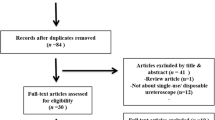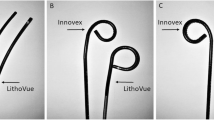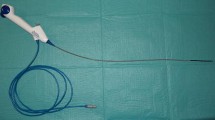Abstract
Introduction
Retrograde intrarenal surgery (RIRS) represents a standard option for kidney stone removal. However, RIRS is considered a cost-intensive procedure. Single-use flexible ureterorenoscopes have been introduced to improve budget predictability in RIRS. We assessed differences in physical and optical properties of single-use devices compared to standard reusable endoscopes.
Methods
In two single-use (LithoVue™, Boston Scientific; Pusen Uscope UE3011™), and one reusable ureterorenoscope (Flex-Xc™, Karl Storz), we investigated flow rates, deflection, illuminance, and intrapelvic pressure in a porcine kidney model. Subjective image quality was assessed using a standardized questionnaire. Common insertable devices were applied to investigate additional influence on physical properties.
Results
Significant variability in maximum flow rates was observed (Flex-Xc™: 25.8 ml/min, LithoVue™: 30.3 ml/min, Pusen™: 33.4 ml/min, p < 0.05). Insertion of a guide wire resulted in the highest reduction of flow rates in all endoscopes. Flection led to a reduction of absolute flow rates up to 9.4% (Flex-Xc™). Light intensity at 20/50 mm distance was 9090 lx/1857 lx (Flex-Xc™) and 5733 lx/1032 lx (LithoVue™) and 2160 lx/428 lx (Pusen™), respectively (p < 0.05). Subjective image quality score was highest using the Flex-Xc™ endoscope. During manipulation, maximum intrarenal pressure up to 66 mmHg (Pusen™) was measured.
Conclusions
Significant differences in physical and optical properties of single-use or reusable flexible ureterorenoscopes are present, with putative influence on surgical efficacy and complications. Further comparative evaluation of single-use and reusable endoscopes in a clinical scenario is useful. Moreover, utilization of ureteral access sheaths may be considered to avoid renal damage.
Similar content being viewed by others
References
Romero V, Akpinar H, Assimos DG (2010) Kidney stones: a global picture of prevalence, incidence, and associated risk factors. Rev Urol 12(2–3):e86–e96
Ordon M, Urbach D, Mamdani M, Saskin R, Honey RJ, Pace KT (2015) A population based study of the changing demographics of patients undergoing definitive treatment for kidney stone disease. J Urol 193(3):869–874
Geraghty RM, Jones P, Somani BK (2017) Worldwide trends of urinary stone disease treatment over the last two decades: a systematic review. J Endourol 31(6):547–556
Turk C, Petrik A, Sarica K, Seitz C, Skolarikos A, Straub M et al (2016) EAU guidelines on diagnosis and conservative management of urolithiasis. Eur Urol 69(3):468–474
Cansino Alcaide JR, Reinoso Elbers J, Lopez Sanchez D, Perez Gonzalez S, Rodriguez, Aguilera Bazan A et al (2010) Flexible ureterorenoscopy (URS): technique and results. Arch Esp Urol 63(10):862–870
Collins JW, Keeley FX Jr, Timoney A (2004) Cost analysis of flexible ureterorenoscopy. BJU Int. 93(7):1023–1026
Taguchi K, Usawachintachit M, Tzou DT, Sherer BA, Metzler I, Isaacson D et al (2018) Micro-costing analysis demonstrates comparable costs for LithoVue compared to reusable flexible fiberoptic ureteroscopes. J Endourol 32(4):267–273
Abraham JB, Abdelshehid CS, Lee HJ, Box GN, Deane LA, Le T et al (2007) Rapid communication: effects of Steris 1 sterilization and Cidex ortho-phthalaldehyde high-level disinfection on durability of new-generation flexible ureteroscopes. J Endourol 21(9):985–992
Afane JS, Olweny EO, Bercowsky E, Sundaram CP, Dunn MD, Shalhav AL et al (2000) Flexible ureteroscopes: a single center evaluation of the durability and function of the new endoscopes smaller than 9Fr. J Urol 164(4):1164–1168
Stamatelou KK, Francis ME, Jones CA, Nyberg LM, Curhan GC (2003) Time trends in reported prevalence of kidney stones in the United States: 1976–1994. Kidney Int 63(5):1817–1823
Proietti S, Dragos L, Molina W, Doizi S, Giusti G, Traxer O (2016) Comparison of new single-use digital flexible ureteroscope versus nondisposable fiber optic and digital ureteroscope in a cadaveric model. J Endourol 30(6):655–659
Quayle SS, Ames CD, Lieber D, Yan Y, Landman J (2005) Comparison of optical resolution with digital and standard fiberoptic cystoscopes in an in vitro model. Urology 66(3):489–493
Jung H, Osther PJ (2015) Intraluminal pressure profiles during flexible ureterorenoscopy. Springerplus 4:373
Thomsen HS (1984) Pyelorenal backflow. Clinical and experimental investigations. Radiologic, nuclear, medical and pathoanatomic studies. Dan Med Bull 31(6):438–457
Wilson W (2009) Intrarenal pressures generated during flexible deflectable ureterorenoscopy. J Endourol 4(2):135–141
Zhong W (2008) Does a smaller tract in percutaneous nephrolithotomy contribute to high renal pelvic pressure and postoperative fever? J Endourol 22:2147–2151
Turna B (2007) Percutaneous nephrolithotomy: variables that influence hemorrhage. Urology 69:603–607
Wu C (2017) Comparison of renal pelvic pressure and postoperative fever incidence between standard- and mini-tract percutaneous nephrolithotomy. The Kaohsiung J Med Sci 33(1):36–43
Bedke J, Leichtle U, Lorenz A, Nagele U, Stenzl A, Kruck S (2013) 1.2 French stone retrieval baskets further enhance irrigation flow in flexible ureterorenoscopy. Urolithiasis 41(2):153–157
Pasqui F, Dubosq F, Tchala K, Tligui M, Gattegno B, Thibault P et al (2004) Impact on active scope deflection and irrigation flow of all endoscopic working tools during flexible ureteroscopy. Eur Urol 45(1):58–64
Rehman J, Monga M, Landman J, Lee DI, Felfela T, Conradie MC et al (2003) Characterization of intrapelvic pressure during ureteropyeloscopy with ureteral access sheaths. Urology 61(4):713–718
Gridley CM, Knudsen BE (2017) Digital ureteroscopes: technology update. Res Rep Urol 9:19–25
Ofstead CL, Heymann OL, Quick MR, Johnson EA, Eiland JE, Wetzler HP (2017) The effectiveness of sterilization for flexible ureteroscopes: a real-world study. Am J Infect Control 45(8):888–895
Author information
Authors and Affiliations
Contributions
Author contributions
SR., S.K., S.D.: Protocol development, S.D., L.H. S.R., S.K., E.N., I.C.: Data collection and experiments, S.R., S.D., T.T.: Data analysis and interpretation, A.S., J.B., S.K.: Study supervision, S.R., S.D, A.S.: Manuscript writing/editing, S.D., I.C.: Graphical design/figures.
Corresponding author
Ethics declarations
Conflict of interest
The authors declare that they have no conflict of interest.
Ethical standards
The study was approved by the institutional review board and conducted in accordance with the Helsinki Declaration and START protocol. We take responsibility to the integrity of the data and accuracy of the reported study. All authors have made a substantial contribution to the information or material submitted for publication and approved the final version.
Electronic supplementary material
Below is the link to the electronic supplementary material.
Rights and permissions
About this article
Cite this article
Deininger, S., Haberstock, L., Kruck, S. et al. Single-use versus reusable ureterorenoscopes for retrograde intrarenal surgery (RIRS): systematic comparative analysis of physical and optical properties in three different devices. World J Urol 36, 2059–2063 (2018). https://doi.org/10.1007/s00345-018-2365-9
Received:
Accepted:
Published:
Issue Date:
DOI: https://doi.org/10.1007/s00345-018-2365-9




